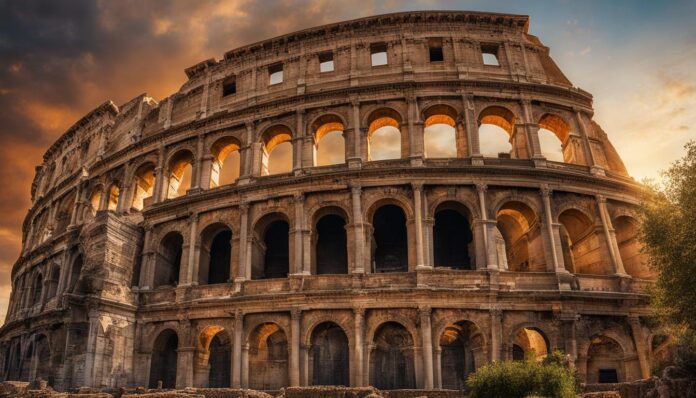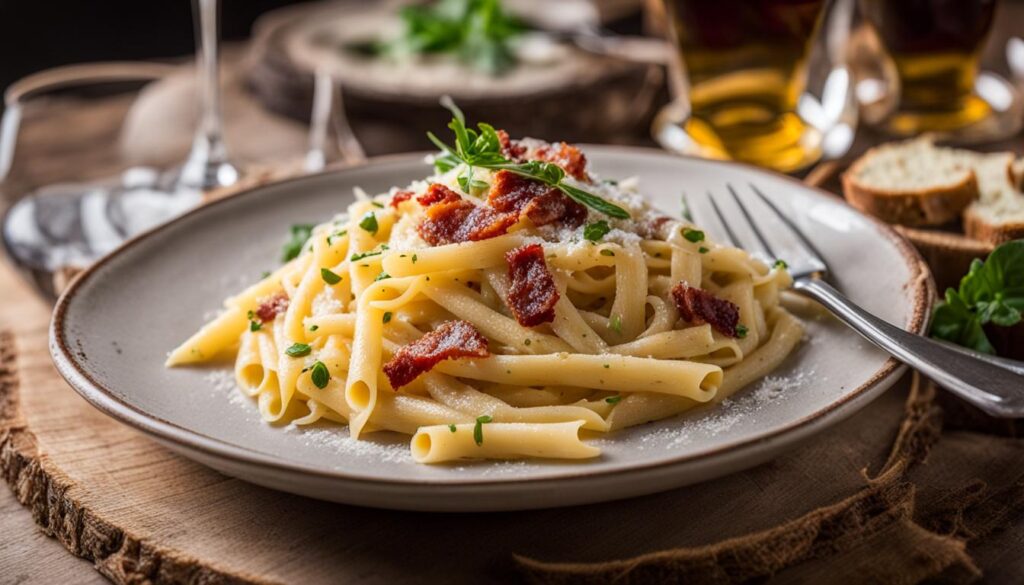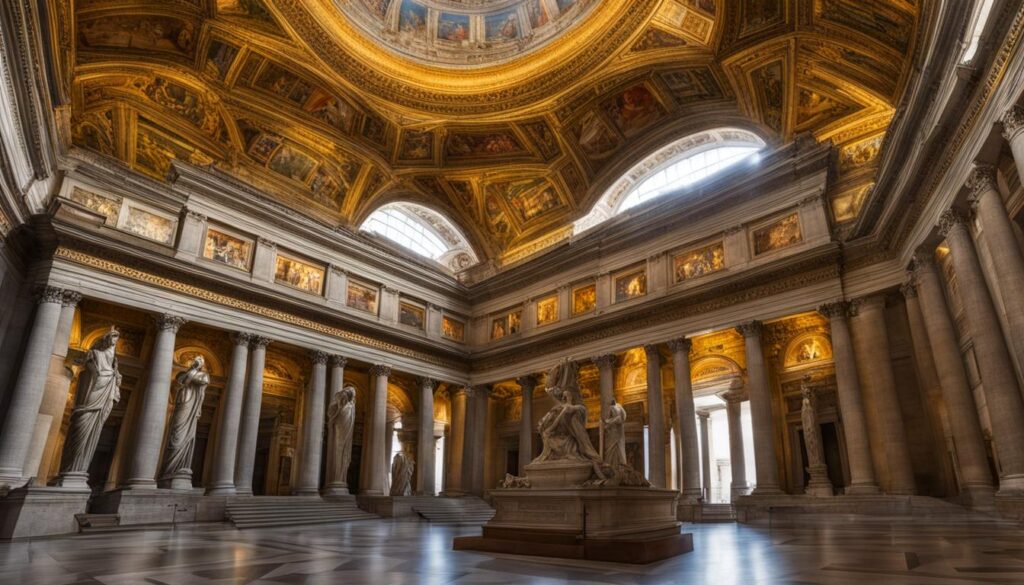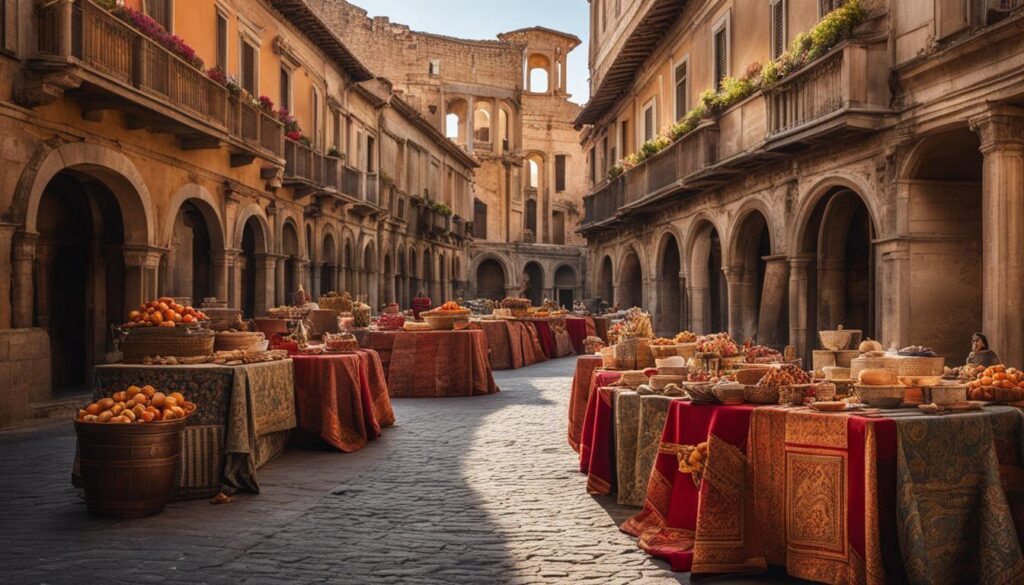Are you planning a trip to Rome and wondering what cultural attractions you shouldn’t miss? Look no further, because we’ve got you covered. Rome is a city steeped in history and culture, and there are plenty of ways to immerse yourself in its rich heritage. Whether you’re interested in ancient monuments, traditional culinary delights, or immersive cultural activities, Rome has something to offer everyone.
Some of the best Roman cultural experiences you can have include visiting the must-visit cultural sites in Rome, such as the Colosseum and the Roman Forum. These ancient landmarks offer a glimpse into the city’s past and the significant role it played in shaping the Roman Empire.
But Rome isn’t just about its ancient history. You can also indulge in traditional Roman cuisine, explore the city’s museums and cultural institutions, attend a Roman theater performance or opera, and even visit underground catacombs.
Immersive cultural activities in Rome abound, from taking a guided Roman cultural tour to participating in traditional festivals and events. Whatever your interest, there is an authentic Roman cultural experience for you.
So, what are some of the must-visit cultural sites in Rome? What are the best Roman cultural experiences you can have? Join us as we explore the top things to do and see in Rome, and discover the richness of Roman culture and heritage.
Explore Rome’s Timeless Monuments and Landmarks
As the center of the Roman Empire, Rome is home to a plethora of awe-inspiring cultural landmarks that continue to attract visitors from around the world. From the iconic Colosseum to the majestic Pantheon, these sites offer a glimpse into the rich history and culture of ancient Rome.
Ancient Monuments of Rome
Walking through the ancient city streets of Rome, you’ll encounter reminders of the great Roman Empire at every turn. The Colosseum, one of the most famous landmarks in Rome, is a testament to the grandeur of ancient Rome and is a must-visit cultural site in the city. Built in AD 80, this magnificent amphitheater was used for gladiatorial contests and public spectacles.
Other notable ancient monuments and cultural landmarks in Rome include:
| Monument | Description |
|---|---|
| The Roman Forum | An ancient square surrounded by ruins of important government buildings. |
| The Pantheon | A former Roman temple with a massive dome and intricate interior. |
| The Arch of Constantine | A triumphal arch located near the Colosseum that commemorates the victory of Constantine the Great. |
These landmarks give insight into the architectural, religious, and political aspects of ancient Rome. Exploring these sites can be an enriching experience that will transport you back in time to witness the glory of the Roman Empire.
Exploring Roman History and Culture
In addition to visiting ancient monuments and cultural landmarks, exploring Roman history and culture through exhibitions and displays is an excellent way to enhance your cultural experience in Rome. The Capitoline Museums, for example, are a group of art and archaeological museums located on the Capitoline Hill in Rome. They house an extensive collection of Roman artifacts and artwork, including sculptures, paintings, and mosaics.
The National Roman Museum is another cultural institution that showcases the rich heritage of Rome. The museum’s collection includes ancient Roman sculptures, frescoes, and mosaics, as well as everyday objects such as ceramics and jewelry.
When exploring Rome’s history and culture, it’s worthwhile to hire a knowledgeable guide who can provide valuable insights into the significance of each landmark and museum exhibit.
Indulge in Traditional Roman Cuisine.
What better way to immerse yourself in Roman culture than through its mouth-watering cuisine? From rich pastas to decadent desserts, traditional Roman dishes are a feast for the senses.
One must-try dish is pasta carbonara, made with spaghetti, eggs, pecorino cheese, guanciale (cured pork cheek), and black pepper. Another delicious option is supplì, a fried rice ball with tomato sauce and mozzarella cheese filling.
If you’re a dessert lover, don’t miss out on tiramisu, a creamy dessert made with ladyfingers, espresso, mascarpone cheese, egg yolks, and sugar.
To truly experience the authenticity of Roman cuisine, head to the local markets like the Campo de’ Fiori and Trionfale Market. Here, you’ll find fresh ingredients used in traditional dishes, as well as other local products like cheese, cured meats, and wines.
For a taste of Roman food culture, attend the Sagra del Carciofo Romano (Roman Artichoke Festival) in April or May. This festival celebrates the city’s beloved artichokes with a variety of dishes featuring this local ingredient. You can also participate in cooking classes and workshops to learn how to make traditional Roman dishes yourself.
Fun fact: The origins of carbonara are unclear, but the dish likely emerged in Rome during or after World War II. Some stories claim that American GIs introduced eggs and bacon to locals, and the dish evolved from there.
When it comes to Roman cuisine, tradition is key. Many dishes and culinary practices have been passed down through generations, making Roman food culture an essential component of the city’s heritage and heritage tourism.
Immerse Yourself in Roman Arts and Traditions
When it comes to Roman culture, art and tradition are deeply intertwined. The Romans were masters of artistic expression, creating intricate works that reflected their values, beliefs, and daily life activities. They also had an array of cultural traditions that formed the backbone of their society. In this section, we will delve into the fascinating world of traditional Roman arts and culture, exploring everything from ancient mosaics to modern-day festivals.
Ancient Roman Art
Ancient Roman art is renowned for its intricate detail and striking imagery. From the enormous arches and columns of the Colosseum to the delicate mosaics found in Roman villas, the Romans left a rich legacy of artistic achievement. The ancient Romans were particularly celebrated for their frescoes, which adorned the walls and ceilings of countless buildings. These frescoes depicted everything from mythological scenes to everyday life in the Roman Empire.
If you want to learn more about Roman art, you can visit one of the city’s many museums and galleries. The Vatican Museums are a must-visit destination for art lovers, housing an extensive collection of works by some of the greatest artists of the Renaissance and beyond, including Michelangelo’s famous Sistine Chapel frescoes. Other notable museums include the Capitoline Museums, which feature many examples of ancient Roman sculpture, and the National Roman Museum, which holds a vast collection of archaeological artifacts from across the Roman Empire.
Traditional Roman Crafts
The Romans were skilled craftspeople, creating everything from jewelry and pottery to clothing and furniture. These traditional crafts have been passed down through the generations and are still practiced by artisans in Rome today. You can explore the various workshops and boutiques in Rome’s charming neighborhoods to see these crafts in action.
One of the best places to find traditional crafts is in the Trastevere neighborhood. This charming area is home to numerous artisan workshops and boutiques, such as the famous Antica Caciara, where you can sample delicious homemade cheeses, and the La Bottega del Cioccolato, which offers an array of mouth-watering chocolate treats. You can also explore the Via del Governo Vecchio, a street that is lined with artisan shops selling everything from handmade leather bags to vintage clothing.
Modern-Day Roman Festivals
Despite being thousands of years old, Roman culture is still very much alive today. One of the best ways to experience this is by attending one of the many festivals and events that take place throughout the year. These festivals showcase the city’s unique cultural heritage and offer visitors a chance to immerse themselves in Roman traditions.
One of the most famous festivals is the Carnival of Rome, which takes place in February each year. The carnival features parades, costumes, and traditional music and dance, and is a highlight of the Roman cultural calendar. Another popular festival is the Rome Film Festival, which attracts filmmakers and film lovers from around the world and features screenings of both classic and contemporary films.
Whether you’re exploring the ancient artworks of the past or participating in modern-day celebrations of Roman culture, there are countless ways to immerse yourself in the rich artistic and cultural traditions of Rome. From the city’s museums and galleries to its bustling markets and vibrant festivals, there truly is something for everyone to enjoy in this fascinating and historic city.
Take a Guided Roman Cultural Tour
Exploring Rome’s culture on your own can be overwhelming. To make the most of your trip, consider joining a guided Roman cultural tour. These tours offer an immersive experience and provide in-depth insights into the city’s rich history and culture.
Benefits of a Guided Tour
With a knowledgeable guide, you can gain a deeper understanding of the significance of ancient landmarks and monuments, such as the Colosseum and Roman Forum. You can also learn about the city’s art, traditions, and cuisine from a local perspective. A guided tour allows you to see the best of Rome’s cultural attractions without worrying about getting lost or missing out on important details.
There are different types of cultural tours available depending on your interests. Some tours focus on specific themes such as religion, architecture, or art, while others cover a broader range of cultural attractions. You can choose the tour that best suits your preferences and schedule.
Popular Roman Cultural Tours
| Tour Name | Description |
|---|---|
| The Vatican Museums and Sistine Chapel Tour | This tour takes you through the Vatican Museums, one of the largest and most impressive art collections in the world. You’ll also get to see the iconic Sistine Chapel and learn about its history and significance. |
| Ancient Rome Tour | This tour covers Rome’s most famous landmarks, including the Colosseum, Roman Forum, and Palatine Hill. With a guide, you can learn about the history and architecture of these ancient structures and gain a deeper understanding of Roman culture. |
| Trastevere Food Tour | Experience the flavors of authentic Roman cuisine on this food tour through the Trastevere neighborhood. You’ll get to sample local delicacies and learn about the history and traditions behind each dish. |
Booking a Roman Cultural Tour
There are many tour companies and options available in Rome. Research different tour companies and read reviews before booking a tour. You can also book tours through your hotel or a travel agency. Be sure to book in advance as tours can fill up quickly, especially during peak season.
Embark on a guided Roman cultural tour and discover the beauty and history of Rome in a comprehensive and immersive way.
Witness Spectacular Roman Festivals and Events
Immerse yourself in the vibrant cultural scene of Rome by attending some of its spectacular festivals and events. With a calendar packed full of immersive cultural activities, Rome offers plenty of opportunities to experience its unique spirit firsthand.
One of the most popular events in Rome is the Carnival, a spectacular festival that celebrates the city’s art, history, and culture. Taking place in February, the Carnival is a vibrant procession of floats, performers, and revelers who take to the streets in a colorful display of costumes and music.
Another must-see event is the Rome Film Festival, which takes place in October and features a lineup of international films, as well as screenings of classic Italian cinema. Rub shoulders with filmmakers, producers, and actors at this prestigious event that celebrates the art of filmmaking.
For a more traditional experience, head to one of the many religious festivals that take place in Rome throughout the year. From the Feast of the Immaculate Conception to the Santo Bambino festival, these events are steeped in history and offer a glimpse into the city’s spiritual traditions.
Experience the grandeur of processions, parades, and performances that showcase the unique spirit of Roman culture. Whether you’re looking to immerse yourself in the traditions of the past or celebrate the modern art and music scene, there’s something for everyone at Rome’s festivals and events.
Visit Rome’s Museums and Cultural Institutions for a Glimpse into the City’s Past.
When it comes to Rome cultural attractions, its museums and cultural institutions are a must-visit for anyone interested in the city’s rich history and cultural heritage. From ancient artifacts to contemporary art exhibits, there is something for everyone to enjoy.
One of the most popular museums is the Vatican Museums, which houses an impressive collection of artwork and artifacts from ancient Rome and beyond. The Sistine Chapel, located within the Vatican Museums, is a must-see for its stunning frescoes painted by Michelangelo.
The Capitoline Museums, located on Capitoline Hill, are another popular destination for those looking to explore Rome’s cultural treasures. The museum’s collection includes ancient sculptures, paintings, and artifacts that offer a glimpse into the city’s past.
The National Roman Museum, located near the Baths of Diocletian, is a great place to learn about Roman history through its extensive collection of ancient artifacts and sculptures. The museum also hosts temporary exhibitions that showcase contemporary art and design.
Here’s a Table of Rome’s Must-Visit Museums:
| Museum | Location | Highlights |
|---|---|---|
| Vatican Museums | Vatican City | Sistine Chapel, ancient artifacts, contemporary art exhibits |
| Capitoline Museums | Capitoline Hill | Ancient sculptures, paintings, artifacts |
| National Roman Museum | Near the Baths of Diocletian | Ancient artifacts, sculptures, temporary contemporary art exhibits |
In addition to these museums, Rome is home to numerous cultural institutions that offer a wealth of cultural experiences. The MAXXI National Museum of 21st Century Arts, located in the Flaminio neighborhood, showcases contemporary art and architecture. The Palazzo delle Esposizioni, located near the Quirinale Palace, hosts a range of cultural events and exhibits, from film screenings to art shows.
Visiting Rome’s museums and cultural institutions is a great way to gain a deeper understanding of the city’s cultural heritage. Whether you’re interested in ancient Roman artifacts or contemporary art, there is something for everyone to discover.
Attend a Roman Theater Performance or Opera.
Immerse yourself in the performing arts of ancient Rome by attending a theater performance or opera in one of the city’s historic venues. The Romans were devoted theatergoers, and their passion for the performing arts continues to thrive today.
Teatro dell’Opera di Roma and Teatro di Marcello are two of the city’s most iconic venues, where you can witness live performances surrounded by the grandeur of Roman architecture.
Attending a theater performance or opera is a must-do experience for anyone interested in the top cultural experiences in the Roman Empire. The music, costumes, and acting will transport you back in time and give you a glimpse into the entertainment that the ancient Romans enjoyed.
Immersive Cultural Activities in Rome
Watching a theater performance or opera is just one of the many immersive cultural activities that you can enjoy in Rome. From attending festivals and events to exploring museums and catacombs, there are endless opportunities to discover the city’s cultural heritage.
“Theater was a Roman invention, and the splendor of performances in Rome was unparalleled.”
Discover Roman Fashion and Shopping
When it comes to fashion and shopping, Rome offers a unique blend of modern trends and traditional craftsmanship. Whether you’re looking for designer boutiques or artisanal shops, the city has something to offer everyone.
History of Roman Fashion
Rome has a rich history of fashion that dates back to ancient times. The famous Toga, which was worn by Roman citizens, is one of the most iconic garments in history. Today, Roman fashion is a fusion of modern styles and traditional techniques, with the emphasis on quality fabrics and craftsmanship.
Exploring Rome’s Fashion Districts
Rome’s fashion districts are a shopper’s paradise. Via del Corso is the city’s main shopping thoroughfare, featuring a mix of high-end brands and affordable boutiques. Via Condotti is a luxury shopper’s dream, with designer stores such as Gucci, Prada, and Bulgari lining the street. For a more traditional shopping experience, head to the historic marketplaces of Campo de’ Fiori and Piazza Navona.
Artisan Shops and Craftsmanship
For a taste of authentic Roman fashion, visit the city’s artisan shops and studios. These small businesses specialize in traditional crafts such as leatherworking, jewelry making, and tailoring. Discover unique pieces made by skilled artisans and learn about the techniques and processes behind their creation.
| Traditional Roman Crafts | Artisan Shop Locations |
|---|---|
| Leatherworking | Testaccio Market |
| Jewelry Making | Piazza Navona |
| Tailoring | Trastevere |
Shopping Events and Festivals
Rome hosts several fashion events and festivals throughout the year. Rome Fashion Week is a must-visit for fashion enthusiasts, featuring runway shows and parties. The AltaRoma fashion event showcases emerging Italian designers and promotes traditional craftsmanship. Additionally, many of the city’s markets and shopping districts hold regular events and promotions.
Whether you’re a fashionista or simply looking for unique souvenirs to take home, Rome’s fashion and shopping scene is not to be missed.
Explore Rome’s Underground Catacombs
Delving into the mysterious underground catacombs of Rome is undoubtedly a unique experience for many visitors. The catacombs are a maze of tunnels and tombs located beneath the city and played an essential role in Roman burial practices. The underground burial sites date back to the second century AD and are a must-visit cultural site in Rome, offering a fascinating insight into the city’s past.
The catacombs offer an eerie but awe-inspiring atmosphere, with frescoes decorating the walls depicting scenes of early Christianity. Visitors can explore the tombs and see the final resting places of thousands of people, including saints, martyrs, and popes. As you wander through the tunnels, you can sense the history and culture of the Roman Empire.
The Catacombs of San Callisto, located on the Appian Way, are some of the most extensive and well-preserved catacombs in Rome. They are home to the remains of many early Christian martyrs and a testament to the city’s Christian heritage. Other popular catacombs include the Catacombs of Priscilla and the Catacombs of St. Agnes.
| Catacombs | Location | Features |
|---|---|---|
| Catacombs of San Callisto | Appian Way | Well-preserved, home to early Christian martyrs |
| Catacombs of St. Agnes | Via Nomentana | Decorated with frescoes and home to the tomb of St. Agnes |
| Catacombs of Priscilla | Via Salaria | Elaborate frescoes and burial site of the early Christian Priscilla family |
Visiting the underground catacombs of Rome is a top cultural experience in the Roman Empire, providing a unique and unforgettable glimpse into the city’s past and the lives of its people.
Experience Roman Holidays and Traditions
Do you want to immerse yourself in authentic Roman cultural experiences? Then explore Rome’s holidays and traditions that have been celebrated for centuries. From ancient festivals to modern-day customs, these traditions provide a glimpse into the heart of Roman culture.
The significance of Roman holidays:
For the ancient Romans, holidays were an integral part of daily life. They celebrated a wide array of festivities, honoring their gods, and commemorating significant events. These holidays provided a break from the routine of daily life and offered an opportunity to connect with family, friends, and the community at large.
Saturnalia:
Saturnalia was one of the most popular Roman festivals, held in honor of the god Saturn. It was a time of feasting, gift-giving, and revelry. During this holiday, social norms were turned upside down, and slaves were allowed to participate in the festivities alongside their masters. This festival was a time of unity and celebration, and it helped to strengthen the bonds between members of Roman society.
Lupercalia:
Lupercalia was another ancient Roman festival that celebrated fertility and the coming of spring. During this holiday, young men would run through the streets wearing only loincloths and brandishing strips of goat hide. They would use these strips to lightly whip women, who believed the ritual would enhance their fertility. This festival was a cultural tradition that celebrated life and procreation.
Modern-day Roman customs:
Modern-day Romans have also preserved cultural customs and traditions that reflect their heritage. For example, every year on June 29, they celebrate the feast day of Peter and Paul, two of the most important apostles of Jesus Christ. This holiday is a time of religious celebration, and it showcases the deep connections between the Catholic Church and Roman culture.
Conclusion
Congratulations on discovering the best cultural experiences in Rome! By exploring the city’s timeless monuments and landmarks, indulging in traditional cuisine, immersing yourself in arts and traditions, taking guided tours, witnessing spectacular festivals and events, visiting museums and cultural institutions, attending theater performances and operas, exploring fashion and shopping, exploring underground catacombs, experiencing Roman holidays and traditions, you will have an unforgettable time in Rome!
Remember, Rome offers a wealth of cultural experiences for visitors. With its rich history and iconic landmarks, unique flavors of traditional dishes, artistic achievements, and diverse festivals and events, there is something for everyone in the Eternal City.
So, whether you are a history buff, foodie, art enthusiast, or simply looking for an adventure, immerse yourself in Roman culture and create lasting memories. Book your trip to Rome and embark on a journey through one of the world’s greatest cultural hubs.














































